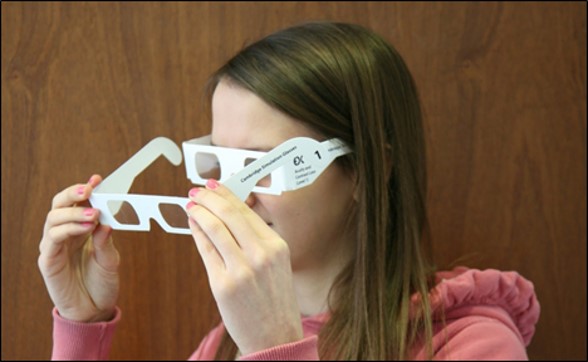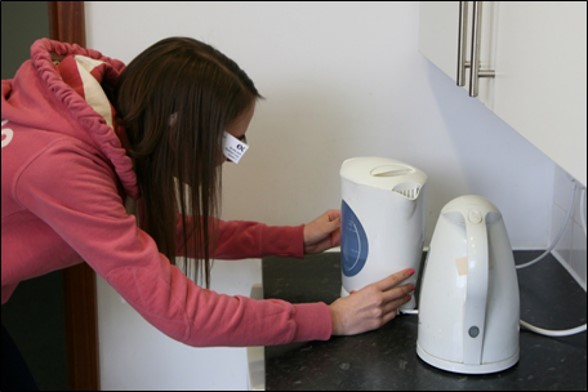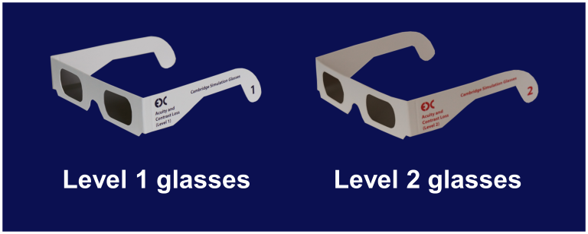Discounts and invoicing
- For charitable purposes, or use within schools and universities, packs of 50 glasses are available at the discounted price of £90*.
- For any other purposes, a 10% discount is available for orders of 100+ pairs of glasses.
- Payments can be made through invoicing your institution.
- For details, please contact:
edc-toolkit@eng.cam.ac.uk
* UK price, which includes delivery & VAT. Worldwide prices vary.
Why should I buy them?
The Cambridge simulation glasses provide insight into the effects of vision loss on product use. They can build empathy with users and can be used to examine the visual accessibility of products and services, helping to create better, more inclusive designs.
Buy single-user pack of 5 glasses (£30*)
Buy multi-user pack of 50 glasses (£150*)
On this page:
Watch this video to see the glasses in action.
What do the glasses do?
These glasses simulate a general loss of the ability to see fine detail, but do not represent any particular eye condition. The effects are representative of an inability to achieve the correct focus, reduced sensitivity of retinal cells, and problems with internal parts of the eye becoming cloudy. These effects typically occur with ageing and the majority of eye conditions, as well as not wearing the most appropriate corrective glasses.
One pair of glasses simulates a mild loss of vision ability. More severe levels of impairment can be simulated by wearing multiple glasses on top of each other. The glasses have been designed to be thin and light-weight to enable this.
Please note that impairment simulation cannot convey what it is really like to live with capability loss on an everyday basis. Therefore, these glasses are intended to be used in combination with other tools as part of a holistic inclusive design evaluation (described within the Evaluate part of Process section of this website). Important issues not covered by these glasses include ensuring compatibility with visual aids and considering those with blind spots, tunnel vision, colour blindness and excessive glare sensitivity.
The glasses can be used to help people to empathise with those with mild vision loss, to compare the visual accessibility of products, and to test a product against our recommended benchmark. If a product passes the benchmark, then this indicates that the product excludes less than 1% of the population, based on their vision capability. Vision test charts and instructions for testing against this benchmark are included in the glasses pack.
Technical details
The glasses have been calibrated to population data, as shown opposite. This gives an estimate of the effect of the glasses on a person’s vision.
The packs contain vision charts. These indicate how many glasses an individual should wear to simulate different levels of vision ability. Different people may have to wear different numbers of glasses to simulate the same resultant vision ability, because their starting vision ability is not the same.
The effects of the glasses were tested with different groups of people as described in Goodman-Deane (2013). The approximate amount that the glasses reduce the wearer’s vision ability is as follows:
- 1 pair of glasses: 0.08 logMAR worse (e,g, 20/20 becomes 20/24)
- 2 pairs of glasses:0.29 logMAR worse (e,g, 20/20 becomes 20/40)
- 3 pairs of glasses: 0.49 logMAR worse (e,g, 20/20 becomes 20/60)
- 4 pairs of glasses: 0.74 logMAR worse (e,g, 20/20 becomes 20/110)
- 6 pairs of glasses: 1.3 logMAR worse (e,g, 20/20 becomes 20/400)
For comparison, the American Optometric Association defines ‘near-normal’ vision as 20/60 (or better). ‘Moderate visual impairment’ is 20/70 to 20/160, and ‘severe visual impairment’ is 20/200 or worse (source).
Further information
Goodman-Deane et al’s (2013) paper entitled ‘Simulating vision loss: What levels of impairment are actually represented?’ describes the studies conducted to determine the technical details. (Published in the Ergonomics & Human Factors 2013 conference). Download the authors’ accepted manuscript version of this paper (pdf).
Chivaran et al’s (2021) paper entitled An Exploratory Study to Understand Visual Accessibility in the Built Environment’ used simulation glasses to assess the visual accessibility of signage and staircases. Download paper.
Product versions
Version 2 of the glasses was launched in May 2013. Version 2 included the calibration to population data and specific instructions for testing a product against our recommended benchmark. This benchmark ensures that it excludes less than 1% of the population, based on their vision capability.
Older versions of the pack included Level 2 glasses, which are equivalent to 2 pairs of Level 1 glasses. If required, Level 2 glasses are still available and can be bought individually, please contact: edc-toolkit@eng.cam.ac.uk for details.
Feedback
We would welcome your feedback on this page:
Privacy policy. If your feedback comments warrant follow-up communication, we will send you an email using the details you have provided. Feedback comments are anonymized and then stored on our file server. If you select the option to receive or contribute to the news bulletin, we will store your name and email address on our file server for the purposes of managing your subscription. You can unsubscribe and have your details deleted at any time, by using our Unsubscribe form. If you select the option to receive an activation code, we will store your name and email address on our fileserver indefinitely. This information will only be used to contact you for the specific purpose that you have indicated; it will not be shared. We use this personal information with your consent, which you can withdraw at any time.
Read more about how we use your personal data. Any e-mails that are sent or received are stored on our mail server for up to 24 months.






